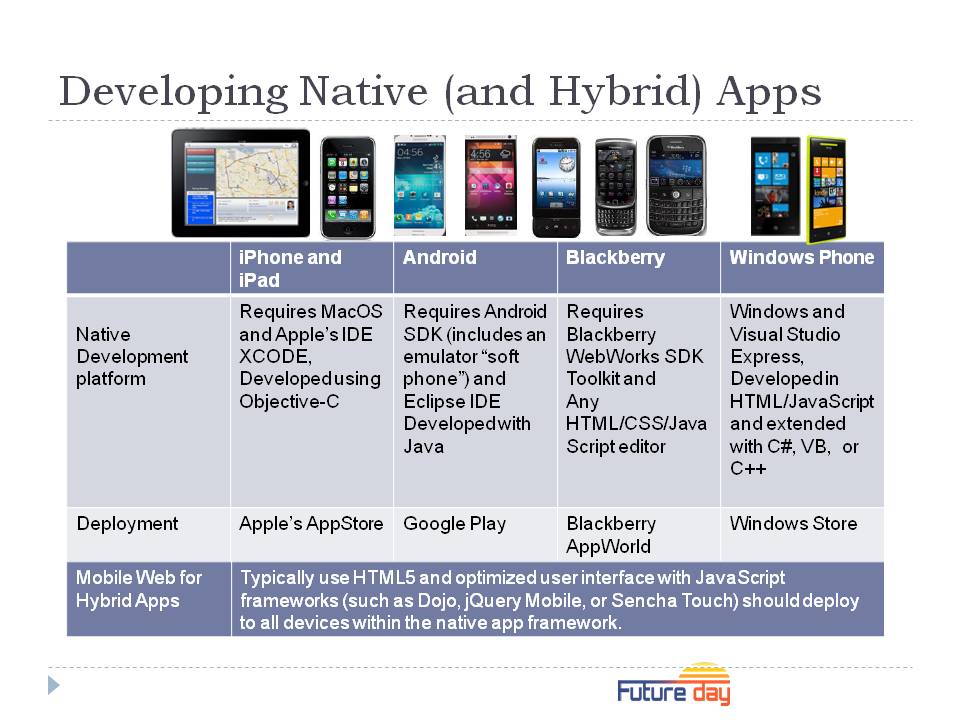While PC shipments have been declining, IDC reports show continued smartphone growth year over year. If your organization isn't committed to mobile application deployment, what are you waiting for?
Just as the Internet, e-commerce, and Software as a Service (SaaS) transformed the nature of business and IT in the '90s and early 2000s, the current game changers or disrupters—mobile, cloud, big data, and social business—continue to transform how businesses must operate and how IT must react. Agility is key to survival, and speed to market is vital.
Statistical analyses concerning the state of mobile computing are almost as prolific as the growth of the actual devices. Consider these compelling statistics:
- Currently, about 30% of Internet traffic comes from smartphones with mobile Internet usage expected to surpass desktop Internet usage in 2014.
- There are over 1 billion smartphones today out of overall 4 billion mobile phones, but by the end of this year, there should be more mobile devices than people on the planet.
- 91% of mobile users keep their device within arm's reach 100% of the time (do you want constant access to your employees and customers?).
- 75% of mobile shoppers take action after receiving location-based messages (Hello).
- 90% of mobile users use multiple screens as channels come together to create integrated experiences (innovation is key).
- Mobile transactions are growing fast: 96% year-to-year increase in mobile cyber Monday sales between 2012 and 2011 (Wow!).
- Approximately 75% of workers either bring their own or can select their own smartphone, rather than IT choice (BYOD).
- 27% of companies worldwide plan to implement location-based marketing for mobile devices in 2013.
Even taking some of these statistics and predictions with a grain of salt, the evidence is overwhelming that organizations across industry verticals must deliver apps, integrated with systems of record (ERP), to employees (Business to Enterprise) and customers and prospects (Business to Consumer) via this vitally important new channel.
Another key consideration: Developing and deploying mobile applications must be more dynamic than maintenance of traditional applications, requiring continual improvements and changes, to take advantage of evolving capabilities and market shifts.
Developing Mobile Apps
If constant change isn't challenge enough, the big question facing many CIOs today is how to develop enterprise mobile apps for all the key mobile platforms. Just assuming that access to your existing Web site on the mobile device will be sufficient is shortsighted, although perhaps a good first step. Ensuring that you have a mobile/ HTML5 version of your site is an even better first step, but ultimately you will want to deploy apps, accessible via the device's native application market. In this scenario, you can target either fully native mobile applications or hybrid approaches, which combine native with mobile HTML5 solutions.
But this is where things can get complicated, as native app deployment for the various smartphones—iPhone, Android (over 100 form factors), BlackBerry, and Windows Phone—is non-trivial, especially if you want to accommodate all of them.

Figure 1: How does a business choose which devices to support?
Mobile apps are much more than just another interface, and there are many design elements and business process considerations. Not only is mobile changing the way business is conducted and the nature of the user, but there are many new functional capabilities that can make your app powerful. The most obvious ones involve touch-screen and real estate, geolocation (ability to get and track user's location), voice-to-text or voice commands, and camera capture interfaces. Additional design considerations could involve an accelerometer to capture device motion, a compass, access to contacts and notifications, and media playing.
Some Mobile Terminology
These are a few mobile terms that you will hear and should consider in your planning:
- BYOD—Bring Your Own Device refers to the growing trend whereby employees will bring their own devices (usually smartphones or tablets) and expect to gain access to enterprise systems. This increases the challenges for IT as they can no longer dictate the end user device and must handle deployment, management, and security risks.
- MEAP—Mobile Enterprise Application Platform provides "Write Once Run Anywhere" ability to build mobile applications, connects to and runs backend systems for mobile.
- MAM—Mobile Application Management provides capabilities for app delivery and updating, app version management, push services, reporting, app disable, runtime security tests, and enterprise app store for distribution.
- MDM—Mobile Device Management technology allows IT to manage and secure applications and mobile devices (e.g., wipe device, remote locking) and provide access to enterprise resources.
Getting Started
When selecting your development tools and approach for developing and managing your enterprise mobile applications, my key recommendations are:
- This is an important strategic initiative for your organization. Using a quick and inexpensive tool may not be worth the time you invest in trying to make it work.
- Most organizations don't want to manage native development for all the different mobile devices. Investing in an MEAP solution that will allow you to develop, maintain, and deploy to multiple platforms (continually) will save your organization in the long run. The goal should be "build once, run on multiple platforms." Today that means iOS and Android for sure and possibly BlackBerry and Windows Phone, as well.
- Remember, mobile is not just another user interface; it's changing everything. Spend time with key stakeholders to consider how mobile affects your business and how you can take full advantage of the new design possibilities with smartphones and tablets.
- Make sure there's flexibility so that you can leverage the latest mobile interface design, using open and third-party JS libraries and plug-ins.
- Management, version control, security, ability to test, and quality assurance are all important considerations when you're going to release mobile solutions.
- MDM and MAM capabilities—such as push notification, service management, functional and authentication testing, analytics and usage reporting, an enterprise App Center for distribution and Session Management—will be important.
So the trick is to juggle the urgency to act with the necessity to implement a mobile development platform that allows your organization to easily evolve and manage mobile apps for a range of platforms both today and in the future.
Here is an animated, short video I produced to illustrate some of the challenges with BYOD and other concepts in this article: https://vimeo.com/73739613












 Business users want new applications now. Market and regulatory pressures require faster application updates and delivery into production. Your IBM i developers may be approaching retirement, and you see no sure way to fill their positions with experienced developers. In addition, you may be caught between maintaining your existing applications and the uncertainty of moving to something new.
Business users want new applications now. Market and regulatory pressures require faster application updates and delivery into production. Your IBM i developers may be approaching retirement, and you see no sure way to fill their positions with experienced developers. In addition, you may be caught between maintaining your existing applications and the uncertainty of moving to something new. IT managers hoping to find new IBM i talent are discovering that the pool of experienced RPG programmers and operators or administrators with intimate knowledge of the operating system and the applications that run on it is small. This begs the question: How will you manage the platform that supports such a big part of your business? This guide offers strategies and software suggestions to help you plan IT staffing and resources and smooth the transition after your AS/400 talent retires. Read on to learn:
IT managers hoping to find new IBM i talent are discovering that the pool of experienced RPG programmers and operators or administrators with intimate knowledge of the operating system and the applications that run on it is small. This begs the question: How will you manage the platform that supports such a big part of your business? This guide offers strategies and software suggestions to help you plan IT staffing and resources and smooth the transition after your AS/400 talent retires. Read on to learn:
LATEST COMMENTS
MC Press Online